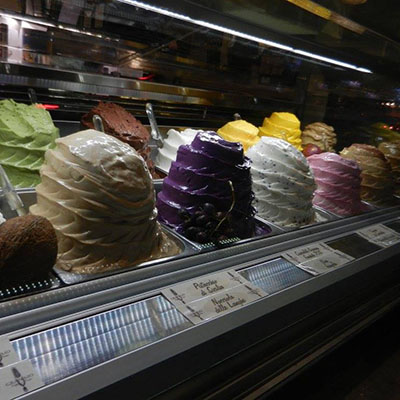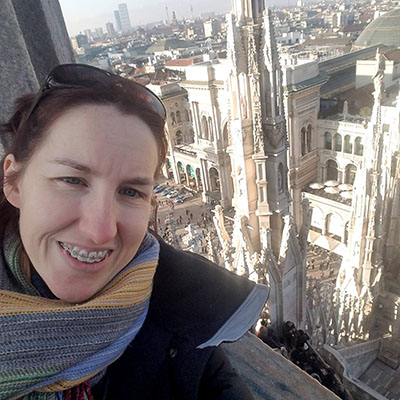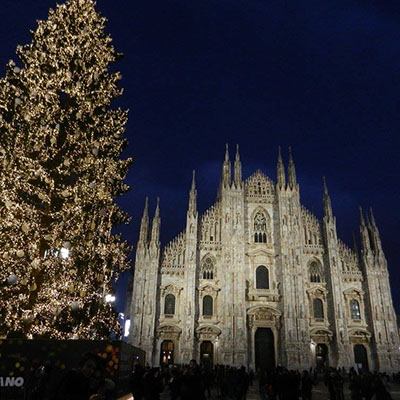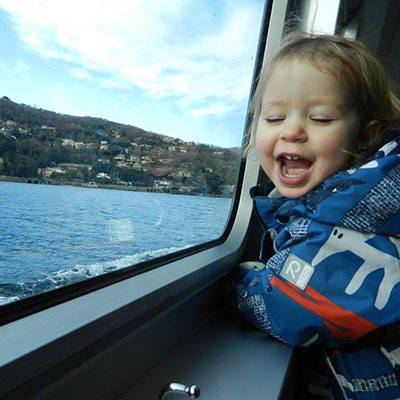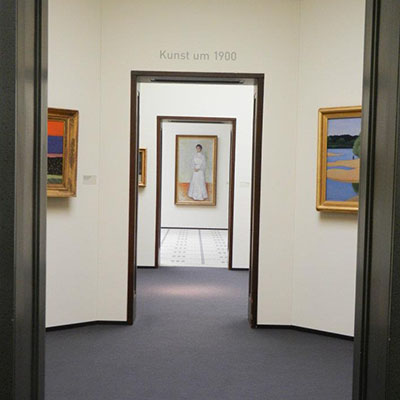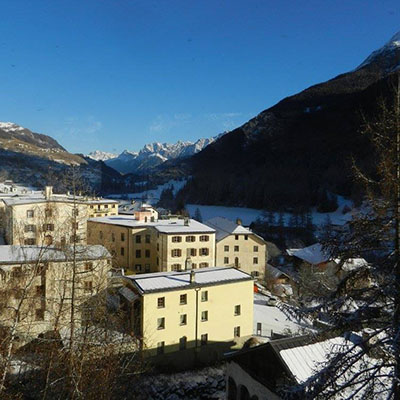The prospect of holiday travel is equal parts exciting and intimidating. Luckily, you can learn from those who have literally gone before you.
How to Celebrate Christmas in Europe
My first European Christmas vacation was in 2016 to visit an intercontinental friend couple (she’s American, he’s Swiss) at their home near Zürich. I returned with my sister a year later when we branched out and added a brief tour of Italy to our Swiss holiday.
Over the years, I’ve learned a bit about traveling in and around Switzerland.
What is the most magical Christmas city in Europe?
Every city has its own flavor, although I’m partial to the holiday attractions in smaller towns. Christmas markets are one of my favorite things to do in Europe at holiday time, and I appreciate the stronger community feel of these festivals when you get away from the major cities. Plus, you can usually enjoy them at a more leisurely pace when they aren’t packed with quite so many people.
My favorite Christkindlmarkt food is Baumstriezel, or chimney cake, from a stall on the Swiss/German border near Lake Constance. The best community atmosphere (despite a grumpy-looking Santa): Bergamo, Italy.
Is Christmas a good time to travel to Europe?
Europe offers a lot of diversion and entertainment at Christmastime, ranging from the traditional to the eclectic. There’s still enough “old world” charm remaining that you’ll see some brilliant displays and hear moving carols.
Europe is hardly stodgy, though. If what you’re looking for is a modern take on some classic traditions or something entirely new, you’ll find that, too, especially in larger cities.
Is it expensive to travel to Europe at Christmas?
The short answer is that yes, traveling to Europe at Christmas can be expensive. Flights tend to cost more, but you’ll find that for any destination at this time of year. If you plan your trip during a particular event — like Pamplona, Spain, during the summer’s running of the bulls — hotels are likely to cost more as well.
That being said, with some thorough research and a bit of flexibility in your plans, you can find ways to reduce costs. For example, book a hotel or find a hostel that’s a bit farther from the center of all the action, and then rely on public transportation to take you to the sites. An off-the-tourist-path location will save you some money, even if you end up spending more on bus or subway tickets.
Winter in Europe Itinerary: Two Weeks in Italy and Switzerland
I’ve been to Switzerland several times, sometimes staying in the Zürich area and sometimes using it as a homebase while road tripping to bordering countries. The itinerary below is a combination of many of those trips.
Day 1: Arrive in Milan.
Milan has three international airports: Milan Malpensa, Milan Linate, and Milan Bergamo, also known as Orio al Serio. If you’re coming from the U.S., most flights will chart your arrival to Malpensa or Linate.
Spend the start of your trip getting acquainted with Milan. There’s a tourist information center at the main train station as well as near key tourist sites, like the Duomo, around the city. Even if I’m using my phone for navigation, I like to grab an old-school paper map to help me get a better idea of where my wish-list sites are in relation to each other. I’ll also take notes on the map and keep it as a souvenir (I’m looking at my Milan map now as I refresh my memory).
The subway, or metro, while not a sexy mode of transportation, is reliable and makes it simple to get around. The city is broken into zones, with Zone 1 being the city center where you’ll find sites like the Duomo di Milano and Parco Sempione. Eight other zones then work around the central hub like a clock or spokes on a wheel.
Metro and bus tickets can be purchased at electronic kiosks at any of the stations, and you’ll choose your ticket based on what zone(s) you’re traveling through and how many trips you’re taking. For example, a short, one-way trip to Zone 1 will probably be cheapest, but if you’re going to zip around or will be in Milan for several days, you can choose a weekly ticket for a bit more.
Traveling with my sister, friend, and her then-two-year-old daughter, we chose a couple of ATM biglietto urbano fares (good for 90 minutes from purchase) and an abbonamento bigiornaliero urbano (a two-day ticket) for our long weekend in Milan. This was the most cost-effective combination for us since we were staying at the Hotel Mozart on the outskirts of Zone 1. Kids under 14 years old may be able to ride for free, so if you’re traveling with family, it’s worth looking into the rules.
Once you know how to get around, it’s time to fuel up for the forthcoming days of sightseeing. After checking into our hotel, I snacked on arrancini purchased at a little shop in the same square. With a short line of what looked to be locals also grabbing a bite, it was a safe bet to find something tasty. I was not disappointed.
And if you have your heart set on gelato, don’t let the fact that it’s December get in the way. Even in winter, you’ll find gelato shops with a full menu. Leave your gloves on and dig in.
Milan is a city of crisscrossing, zigzagging, diagonal streets that lead you to unexpected piazzas, sometimes large, and other times small and unassuming. Give yourself permission to get a little lost and follow whatever path looks most attractive.
It gets dark early in December — around 5 p.m. While that makes sightseeing a challenge most times of the year, it works to your advantage around Christmastime. Milan literally lights up with special displays and twinkling lights strung over alleyways. Even if you walked down the same street earlier in the day, it’ll have a very different feel once the sun goes down.
Day 2: Climb the Duomo di Milano.
One of the highlights of our trip was the Duomo di Milano, the imposing cathedral at the center of the city. I recommend making at least two visits: once during the day when you can climb to the roof, and again at night, even if just to see the façade. It will feel like you’re visiting two different sites with the extreme change in lighting. And at Christmastime, the plaza will be lit up beautifully with holiday décor in the evening.
For the price of a Duomo terraces ticket, you get access to the interior of the cathedral and its rooftop. We purchased our tickets from the gift shop the same day, but you can buy them online a few days in advance. Note that admission is restricted during events in the Duomo, which may happen more often during Christmastime, so plan accordingly.
The Duomo’s interior is everything you’d hope for from one of Italy’s most iconic churches. Soaring ceilings lend themselves to incredible acoustics, and we were treated to a practice session for that evening’s musical performance. It was the kind of sound you feel in your chest as much as you hear. We could hardly have asked for a more perfect soundtrack for exploring the sheer artistry of the church.
The toughest decisions will be where to look next, although up is always a good option. Let your jaw drop as you take in the towering pillars, intricate ceilings, stained glass, paintings, and statues from below.
After a lap (or two or five) around the interior, make your way to the terraces. My ticket was to ascend by the stairs (a piedi), but there is a lift. This might not be for everyone, particularly if you have a fear of heights or mobility challenges. You’re really walking along the rooftop, which isn’t always flat and sometimes requires a bit of stepping over and stooping under things.
If you can make it, though, it’s well worth the price of the ticket. Few places give you such an up-close-and-personal look at the high spires and stonework of churches. You won’t find a better view of the skyline either. You almost feel like you’re getting away with something mischievous spying on all the tourists in the plaza below.
Use your nighttime visit to simply take in the holiday atmosphere. Simple lighting on the cathedral’s exterior gives it an even more dramatic feel. The relief in the stonework stands out with greater depth, and there’s a sense of mystery you don’t feel during the day.
After dark, the Piazza del Duomo simply twinkles. Holiday lights projected on the surrounding building facades call to mind stars and snowflakes. And a giant Christmas tree brightens things even more.
The Christmas market just outside the Duomo isn’t the largest we went to — and we went to a lot — but we each walked away with unique gifts, including a dainty ornament of an Italian Santa. Unlike American Santa, he’s quite skinny and in need of some more pizzelle cookies.
Days 3-4: Soak up Milan.
Give yourself a couple more days to explore the city’s highlights and see for yourself why Milan is worth visiting. I found it to be a pretty walkable city, even in winter. It is large, though, so take advantage of the subway trains. We often rode the subway from our hotel to the station in the middle of the Piazza del Duomo, using that as our jumping off point for the day’s sightseeing.
Castello Sforzesco (Sforza Castle), northwest of the Duomo di Milano, was built as a defensive structure in the 1300s, then partially destroyed in the 15th century. It was then rebuilt as a palace until being converted back for military purposes for several centuries. Today, it’s a museum dedicated to the city’s history and art.
Highlighting my visit was the chance to see The Pietà Rondanini, Michaelangelo’s final work. The sculpture was left unfinished due to his death.
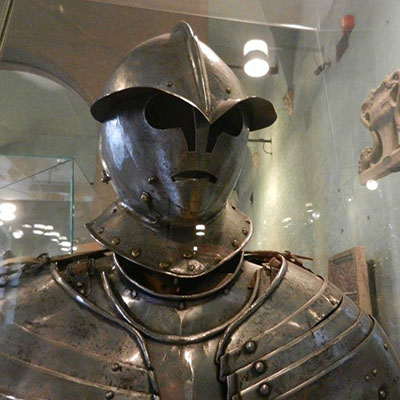
If you’re into any kind of history or art, Castello Sforzesco is worth the time and admission fee (€5 when I visited in 2017, up to €10 in 2023). A musical lightshow at night added a festive feel to the castle at night when we were there, and all we had to do was hang out in the square outside the main tower to see it.
If you’re walking to the castle from the Duomo, your route might take you by La Scala Opera House. Stop by the museum if you have time.
Like many Italian cities, Milan is not short on churches, and it’s not all about the Duomo. I am not a deeply religious person, but I do appreciate the architecture and artistry that goes into Italian churches. In Milan, you’ll see such a wide variety, too.
The Basilica di Sant’Ambrogio (Basilica of St. Ambrose) was memorable in part because of how understated it was compared to so many other churches in Italy.
Built in the fourth century before Gothic and Baroque architecture took over, it is still a working Catholic church. If your visit is like ours, you’ll find it supremely quiet, even during the holiday season. As the brochure says (yes, I still have it), “Feel sincerely welcomed, with your personal history, your faith, your questions, your dreams.”
Just around the corner is the Dominican convent, Santa Maria delle Grazie, home of Leonardo da Vinci’s The Last Supper.
Break up your sightseeing with a bit of window shopping. You’re in Milan, after all. The city is known for fashion and glamor on a regular day, but at Christmastime, everything has a bit more shine.
Day 5: Cruise Lake Como on a day trip.
There’s still plenty to see in Milan, but if you’re looking for a quick change of scenery or want to explore a bit further afield, consider a day trip to the Italian Lake District. In less than an hour by train, you can be at Lake Como, where we stopped in Como City.
This is a summer town. Visit Lake Como in the winter and it feels strangely sleepy and deserted. While you’re unlikely to spot any celebrities at Christmastime, it can be a more budget-friendly and less crowded time to visit.
During our afternoon in Como, we took the obligatory stroll through the Christmas market where I most vividly remember the food: a giant ham and cheese pretzel, picked primarily because it was hot and the wind off the lake was freezing, and an aragosta, which I had been eyeing throughout our trip in Italy but had yet to try. While I had high hopes, this lobster-tail looking pastry was dry and difficult to eat without exploding little flaky bits everywhere with each bite.
We booked a short boat ride around the lake. Most of the time was spent in the covered seating area inside where we could warm up, but it still afforded views of the extravagant houses along the shore. Being the off-season, we had the boat nearly to ourselves.
Make your way back from the lake, through the market, and to the Cattedrale di Como to warm up a bit. Primarily built in the Gothic style, and with it being a chill, dreary day, it had a bit of a foreboding appearance. Don’t let that scare you off, though. On a brighter day, it would have been a totally different experience. Be sure to check out the ornate “original” organ (versus the one installed in the 1980s) on your self-guided tour inside.
Day 6: Travel to Zürich.
It’s time to leave Italy for now and head north toward Switzerland and its largest city — Zürich.
Train travel is so easy in this part of Europe, so for this leg of your journey, I recommend going by rail. Depending on whether you get a direct ticket or have to change trains, the trip can take three to five hours.
I know it sounds cliché, but Italian trains are a little less reliable than Swiss in terms of staying on time. In all my travels, I don’t think I’ve ever had a train delayed when traveling with a Swiss rail company. I can’t say the same for Trenitalia, though. Still, take a deep breath and go with the flow, delays or not.
On average, a ticket from Milan to Zürich will cost about $30 USD, which in my book is quite reasonable, especially when you consider the excellent views and people watching en route. We purchased our tickets at the station on the day of travel, but if you’re making the trip at peak holiday time, it could be worth booking in advance to ensure you’ll have a seat.
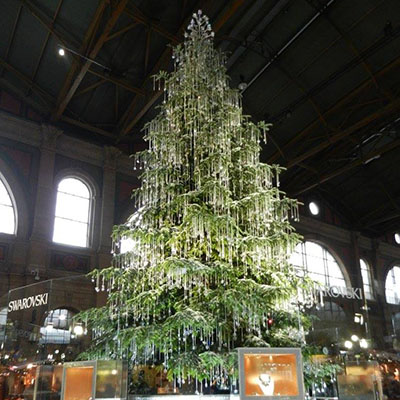
It’s a good place to refuel on hearty Swiss German food or delightfully sweet pastries after a long train ride. A simple wurst is easy to eat while you walk, as tables will be hard to come by. Pair it with glühwein (mulled wine) and cap things off with some hot, fresh apfelküchle (öpfelchüchli in Swiss German, or sliced apples dipped in batter and pan-fried).
You'll also find a massive Christmas tree. When I was there, it was extravagantly decorated with Swarovski crystal ornaments. Organizers are reportedly toning things down a bit in 2023, though. You'll find electric bikes where your pedaling will power the tree’s lights. You might need the exercise after a third chocolate croissant.
It can feel quite crowded since it’s an indoor market and space is limited. If lots of people bother you, avoid going in the evening around mealtime, plan your visit so it’s not too near Christmas Day, or visit an outdoor Christkindlmarkt instead.
Be sure to catch a caroling performance by local school children in one of the squares near a market before you call it a night.
Days 7-8: Celebrate the Swiss way.
Zürich, like Milan, is home to high-end shopping. Even if you can’t afford anything in the shops, it’s worth looking around. Personally not one for fashion, I prefer the stores displaying their sweet treats in the windows.

As you work up an appetite, now might be a good time to plan your holiday meal if you’ll be in Zürich on Christmas Day. The Swiss are fiercely protective of their Sundays and holidays, reserving them as a time for family and rest. Stocking up on something to eat in case you can’t find an open shop or restaurant later is a good idea.
If you won’t want to or can’t cook for yourself, make a restaurant reservation. Hotels or restaurants near them have the best odds of remaining open on Christmas.
A traditional Swiss Christmas Eve dinner includes a Fondue Chinoise or Fondue Bourguignonne. Unlike the heavy cheese fondue we often think of in the United States, these involve cooking thinly sliced meat in hot oil (Chinoise) or broth (Bourguignonne).
This fondue is served with sauces, pickled vegetables — reportedly to help with digestion — and some other side dishes. We had noisettes, little fluffy potato balls I was happy to find could be bought frozen from my local Aldi back home.
Having to cook your meat one slice at a time is the perfect way to spend a leisurely holiday meal. The forced slower pace lets you be in the moment and enjoy the people you’re with.
Although not the Swiss capital, Zürich is a major hub of activity. That means you can fill your remaining time exploring some of the key sites of the city.
I’ve always spent a bit of time wandering the Old Town during my visits to Zürich. It’s a nice way to get your bearings, and the walkways along the water are always relaxing (even in bad weather, and I’ve been there in heat, rain, snow …).
While Switzerland isn’t the most religious of European countries, you can still get your fix of touring churches. A couple of them — Fraumünster Church and Grossmünster Church — are particularly proud of the provenance of their stained-glass windows. Fraumünster features glass work by Marc Chagall, something my expat friend reminds me of each time I visit.
If you have the energy for it, climbing the 187 steps of the Grossmünster tower is worth the effort. You’ll be treated to views of Zurichsee (Lake Zürich), the mountains, and the rest of the Old Town The price of admission is quite reasonable at CHF 5 (less than $6 USD as of September 2023), and it entitles you to a discount on your admission at the Kunsthaus Zürich (Museum of Art).
Kunsthaus Zürich is an excellent way to spend a cold day. Rodin’s Gates of Hell are on display outside the front entrance, and paintings by the great masters like Monet and van Gogh continue inside. You’ll also find works by Swiss artists as well as modern and contemporary pieces. I originally ended up here to escape some lousy weather back in 2012. It turned out quite lucky as it is a beautifully done museum.
For more outside fun and panoramic views of Zurichsee and the city, make the trek up Uetliberg Mountain. The hiking trail to the top of this nearly 3,000-foot mountain makes for an enjoyable tree-covered walk.
In the winter, you might be lucky enough for an unspoiled snow-covered stroll. Some of the hiking trails convert to sled runs in the winter, too. If getting to the top under your own steam isn’t your cup of tea, though, you can take the train from the main station in Zürich.
Once at the top, take in the scene from the observation tower and have lunch at one of the restaurants. English menus are readily available for those whose German is as shaky as mine, but the food is pure Switzerland. I’m partial to the spätzle.
There’s a Christmas market at the top of Uetliberg in the winter as well. Dress warm if you plan to spend any time outdoors here.
Day 9: Travel to Scuol.
Let’s get out of the city for a few days and head west to Scuol. You can take the train — it will take about three hours, slightly more or less depending on how long you have to wait when you change trains at a midway point — or rent a car. Scuol is a smaller village, so while there are buses around town, public transportation is not quite as abundant as you might be used to. A rental car could give you greater independence as you explore.
This is a skiing region in a country that loves to ski. Some reports say 35% of the Swiss population skis regularly, and Scuol is only about 37 miles (60km) from St. Moritz, twice the host of the Winter Olympics. Before you hit the slopes, though, check out what else Scuol has to offer.
In addition to great skiing terrain, you’ll find hot spring resorts. Unwind from recent travel and prepare for the next few days of activity with some time in the spa baths, which are said to have healing properties.
The Swiss National Park is also worth visiting as is Che Chaschöl, the local cheese factory (as long as you don’t have a dairy intolerance, I suppose).
Day 10: Take a day trip to Lake Resia.
Before you ski — or if you need a day of rest or are waiting for better weather — make the short mountain drive across the Italian border to Lake Resia (Reschensee in German, Lago di Resia in Italian).
A word of caution: If you get car sick on curvy roads, this might not be the route for you. Neither the Little Swiss Miss, about two years old at the time, nor her father enjoyed the winding pass from the backseat.
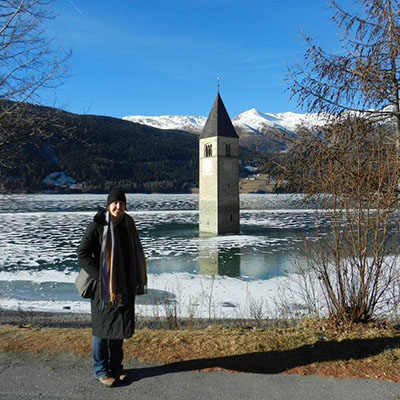
Essentially a ghost town — we only saw a handful of other visitors, and residents were relocated decades ago — the shoreline was a peaceful place to walk and take in the Alpine views. Had it been colder and the lake fully frozen, we could have walked out to the tower itself.
The lake was drained temporarily in 2021, revealing the remains of the village. The Upper Val Venosta Valley Museum (Museum Vintschger Oberland in German or Museo Alta Val Venosta in Italian) tells the story of the dam and its obvious impact on the city. However, it is closed in the winter. You’ll have to put that one on your list for a return visit in the summer.
Admittedly there’s not much in the way of activity around Lake Resia. Its main appeal comes from the way it forces you to slow down, breathe in the crisp mountain air, and be present in your beautiful surroundings. It’s the ideal opportunity to just be and reflect.
On your way back to Scuol, stop in Austria for a bit of grocery shopping. First of all, it’s fun to grocery shop in another country. But second, you’ll likely find that most goods are noticeably cheaper in Austria than they are in Switzerland.
Day 11-12: Hit the slopes.
There are several ski resorts in the Scuol/Engadin area, although we didn’t manage to make it to any of them on our visit. The weather was unseasonably warm that December, and there wasn’t enough snow. Our plans to cross country ski were cancelled.
If you have better luck than we did, you’ll be able to hit the slopes. Motta Naluns is a popular resort in the area with about 43 miles (70km) of runs throughout the valley. Weather permitting, you’ll find plenty of opportunity for downhill skiing and snowboarding.
Motta Naluns also has barrier-free skiing for those looking for greater accessibility than your average ski resort. This includes dual skiing with an instructor.
Most resorts have ski schools if you’re new to the powder or have kids who need extra instruction. Also ask about equipment rental and transportation if you need it. Some offer a bus service to and from Scuol.
With its mountain passes and forested areas, this is also a gorgeous place for snowshoeing. If you’ve never tried snowshoeing before, I recommend booking a guided tour rather than striking out on your own. Regardless of whether you trek out with a professional or go solo, pay attention to the weather conditions and avalanche alerts. While skiing and snow activities are generally safe, they’re never completely without risk.
Day 13: Make your next move.
The Scuol-Tarasp train station is the end of the railway line, so when you’re ready for the next leg of your journey, whether that’s home or on to another European city, you’ll have to backtrack, probably to Landquart. From there, you can keep going back to Zürich — most routes will take you to Zürich HB to change trains anyway — or pick a new destination. Continue your holiday travel in another ski town, Basel or Bern, Hamburg or Berlin.
This two-week itinerary packs a lot in for our European Christmas vacation yet still leaves time to make time for yourself, slow down in the midst of the busy holiday season, and truly experience some of the best Switzerland and Italy have to offer. Before booking your winter trip, keep these three basic tips in mind:
- When it comes to weather, hope for the best but plan for the worst. It’s not only about avalanches when you ski or snow disrupting your flights. Leaving gaps in your itinerary can allow you to shift your activities around if you simply decide it’s too cold to visit the Christkindlmarkt tonight. Change your outlook on FOMO (Fear of Missing Out) and instead prioritize the things you want most out of your trip.
- Christmas traditions can be very important to some of us, and that’s okay. When you’re traveling over the holidays, decide which traditions are non-negotiable to you. Try to re-create those, but understand that no matter how hard you try, they still won’t be the same as at home. If a tradition is less important, though, let it go for this year. Or even better, start a new tradition from the road.
- Be a bit of a Scrooge about souvenirs as holiday gifts. It’s tempting to say that you’re going to do all your holiday shopping on the road — so many unique things! — but you’ll quickly tire of hauling presents around, constantly rearranging your suitcase to make more room, and trying not to break that fragile ornament that seemed perfect at the time but is now just an inconvenience.
We have even more tips for traveling in the winter with our guide to holiday travel.
Happy Travels Make for Happy Holidays
Memories of my trips around Europe have always been great. I’ve had my fair share of mishaps too, though, especially when traveling in the winter. Unexpected snowstorms have delayed flights. A (slightly embarrassing) fainting episode in Scuol turned out to be nothing more than jetlag combined with high altitude, but had it been something worse, having the right kind of travel insurance would have made all the difference.
Protect the money you spend for your trip and medical expenses if you get sick or hurt while you travel with the right travel insurance. Seven Corners’ interactive online guide makes it easier than ever to find the best plan for you. But if talking to a real human who can answer all of your questions is more your style, you can also contact our licensed sales team today.
Travel Like a Pro with The Wayfinder
Did you enjoy this blog? Get more articles like it before anyone else when you subscribe to our monthly newsletter, The Wayfinder.
